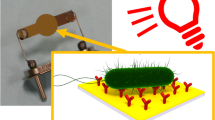Abstract
The affinity reaction between the antibodies to okadaic acid immobilized on the sensor’s surface and the toxin in the solution has been investigated. The affinity constant, as well as the association rate constant and the dissociation rate constant, has been calculated. The unlabeled affinity sensor for the detection of okadaic acid has been developed. The calibration plot is linear in the range of concentrations of 5–500 ng mL−1; the limit of detection is 1.4 ng mL−1. The developed sensor can be successfully used for the detection of toxins in real samples.




Similar content being viewed by others
References
Alexander J, Guðjón Atli A, Benford D (2008) Marine biotoxins in shellfish—okadaic acid and analogues. The EFSA Journal 589:1–62. doi:10.2903/j.efsa.2008.589
Dubois M, Demoulin L, Charlier C, Singh G, Godefroy SB, Campbell K, Elliott CT, Delahaut P (2010) Development of ELISAs for detecting domoic acid, okadaic acid, and saxitoxin and their applicability for the detection of marine toxins in samples collected in Belgium. Food Addit Contam Part A Chem Anal Control Expo Risk Assess 27(6):859–68. doi:10.1080/19440041003662881
Eissa S, Zourob M (2012) A graphene-based electrochemical competitive immunosensor for the sensitive detection of okadaic acid in shellfish. Nanoscale 4:7593–9. doi:10.1039/c2nr32146g
Garibo D, Campbell K, Casanova A, de la Iglesia P, Fernández-Tejedor M, Diogène J, Elliott CT, Campàs M (2014) SPR immunosensor for the detection of okadaic acid in mussels using magnetic particles as antibody carriers. Sensors Actuators B Chem 190:822–8. doi:10.1016/j.snb.2013.09.037
Hayat A, Barthelmebs L, Marty JL (2012) A simple colorimetric enzymatic-assay for okadaic acid detection based on the immobilization of protein phosphatase 2A in sol–gel. J Appl Biochem Biotechnol 166(1):47–56. doi:10.1007/s12010-011-9402-0
Hu L, Liu J, Wang Q, Zhang Y, Jia R, Cai C, Wu W, Chen S-F, He P (2013) Development of an immunochromatographic test for the rapid detection of okadaic acid in shellfish sample. J Appl Phycol 25:1091–9. doi:10.1007/s10811-012-9949-3
Justino CIL, Freitas AC, Duarte AC, Rocha Santos TAP (2015) Sensors and biosensors for monitoring marine contaminants. Trends in Environmental Analytical Chemistry 02/2015. doi: 10.1016/j.teac.2015.02.001
Karaseva NA, Ermolaeva TN (2012) A piezoelectric immunosensor for chloramphenicol detection. Talanta 93:44–8. doi:10.1016/j.talanta.2011.12.047
Karaseva N, Ermolaeva T (2015) A regenerable piezoelectric immunosensor on the basis of electropolymerized polypyrrole for highly selective detection of staphylococcal enterotoxin A in foodstuffs. Microchim Acta 182(7):1329–35. doi:10.1007/s00604-015-1456-1
Kim JH, Suzuki T, Lee KJ, Kim PH, Kamiyama T, Lee TS (2008) The first detection of okadaic acid and its derivatives in Korean bivalves by liquid chromatography-mass spectrometry. Fish Sci 74(2):433–8. doi:10.1111/j.1444-2906.2008.01541.x
Ma JKH, Jun HW, Luzzi LA (1973) Determination of equilibrium constants and binding capacities using a modified Scatchard method in drug-protein binding studies. J Pharm Sci 62(12):2038–2040. doi:10.1002/jps.2600621233
Marcaillou-Le Baut C, Amzil Z, Vernoux JP, Pouchus YF, Bohec M, Simon JF (1994) Studies on the detection of okadaic acid in mussels: preliminary comparison of bioassays. Nat Toxins 2(5):312–7
Perry NB, Ellis G, Blunt JW, Haystead TAJ, Lake RJ, Munro MHG (1998) Okadaic acid in New Zealand sponges: detection by cytotoxicity, protein phosphatase inhibition and immunoassay techniques. Nat Prod Lett 11(4):305–12. doi:10.1080/10575639808044964
Prego-Faraldo MV, Valdiglesias V, Méndez J, Eirín-López JM (2013) Okadaic acid meet and greet: an insight into detection methods, response strategies and genotoxic effects in marine invertebrates. Mar Drugs 11:2829–45. doi:10.3390/md11082829
Product No. 520001. Okadaic acid (DSP) ELISA, microtiter plate, enzyme-linked immunosorbent assay for the determination of okadaic acid in water and contaminated samples.
Skládal P (2003) Piezoelectric quartz crystal sensors applied for bioanalytical assays and characterization of affinity interactions. J Braz Chem Soc 14(4):491–502. doi:10.1590/S0103-50532003000400002
Smienk H, Domínguez E, Ml R-V, Clarke D, Kapp K, Katikou P, Ag C, Otero A, Jm V, Razquin P, Mata L (2013) Quantitative determination of the okadaic acid toxins group by a colorimetric phosphatase inhibition assay: interlaboratory study. Journal of AOA C International 96(1):77–85
Tang Alice XJ, Pravda M, Guilbault GG (2002) Immunosensor for okadaic acid using quartz crystal microbalance. Anal Chim Acta 471:33–40. doi:10.1016/S0003-2670(02)00922-4
Zhang H-Q, Liu W, He X, Liang LJ, Ding W, He Z-Y (2013) Determination of okadaic acid related toxins from shellfish (Sinonovacula constricta) by high performance liquid chromatography tandem mass spectrometry. Agric Sci 4:1–6. doi:10.4236/as.2013.45B001
Acknowledgments
This investigation was supported by the Project 3.2727.2011 “Piezoelectric biosensor of the new generation for the detection of toxins and active compounds,” Ministry of Education and Science of the Russian Federation. We would like to thank Dr. N. Baryshev for critical reading and assistance with the translation of the manuscript.
Author information
Authors and Affiliations
Corresponding author
Ethics declarations
Conflict of Interest
The authors declare that they have no competing interests.
Ethical Approval
This article does not contain any studies with human participants or animals performed by any of the authors.
Rights and permissions
About this article
Cite this article
Karaseva, N.A., Farafonova, O.V. & Ermolaeva, T.N. Highly Sensitive Detection of Okadaic Acid in Seafood Products via the Unlabeled Piezoelectric Sensor. Food Anal. Methods 9, 1495–1501 (2016). https://doi.org/10.1007/s12161-015-0332-2
Received:
Accepted:
Published:
Issue Date:
DOI: https://doi.org/10.1007/s12161-015-0332-2




